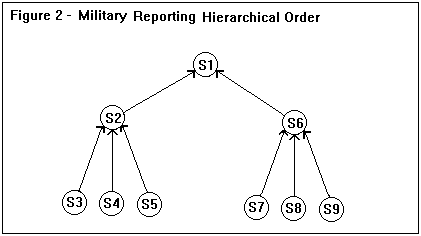 Educational Systems Theory
Educational Systems Theory Educational Systems Theory
Educational Systems Theory


Example 2 - Another example of hierarchical order takes place in the military with a general, several colonels, and several majors. The affect relation is "reports to another." The majors report to their specific colonel, and the colonels report to the general. The general represents one level, the colonels represent a second level, and the majors represent a third level. Note that the major does not report directly to the general, and majors only report to their appropriate colonel. Also note that the channels run in the opposite direction in this example as compared to the previous example. A graphic representation of this might look like Figure 2. S1 represents the general, S2 and S6 each represent a colonel, and S3, S4, S5, S7, S8 and S9 each represent a major.
57. If educational system unilateralness, then hierarchical order.
64. If educational system hierarchical order increases, then vulnerability increases and flexibility decreases.
65. If educational system compactness increases, then hierarchical order decreases.
70. If educational system wholeness increases and hierarchical order is constant, then integration increases.
92. If educational system feedin less than some value decreases, then hierarchical order decreases.
112. If educational system strongness increases and hierarchical order is constant, then regulation decreases.
113. If educational system wholeness increases and hierarchical order is constant, then efficiency decreases.
114. If educational system weakness and hierarchical order, then flexibility decreases.
174. Change in educational system size is greater than change in hierarchical order.
178. If educational system hierarchical order at a given time is greater than some value and size at a given time is greater than some value, then independence at a later time increases.
 Go to SIGGS Home Page.
Go to SIGGS Home Page.